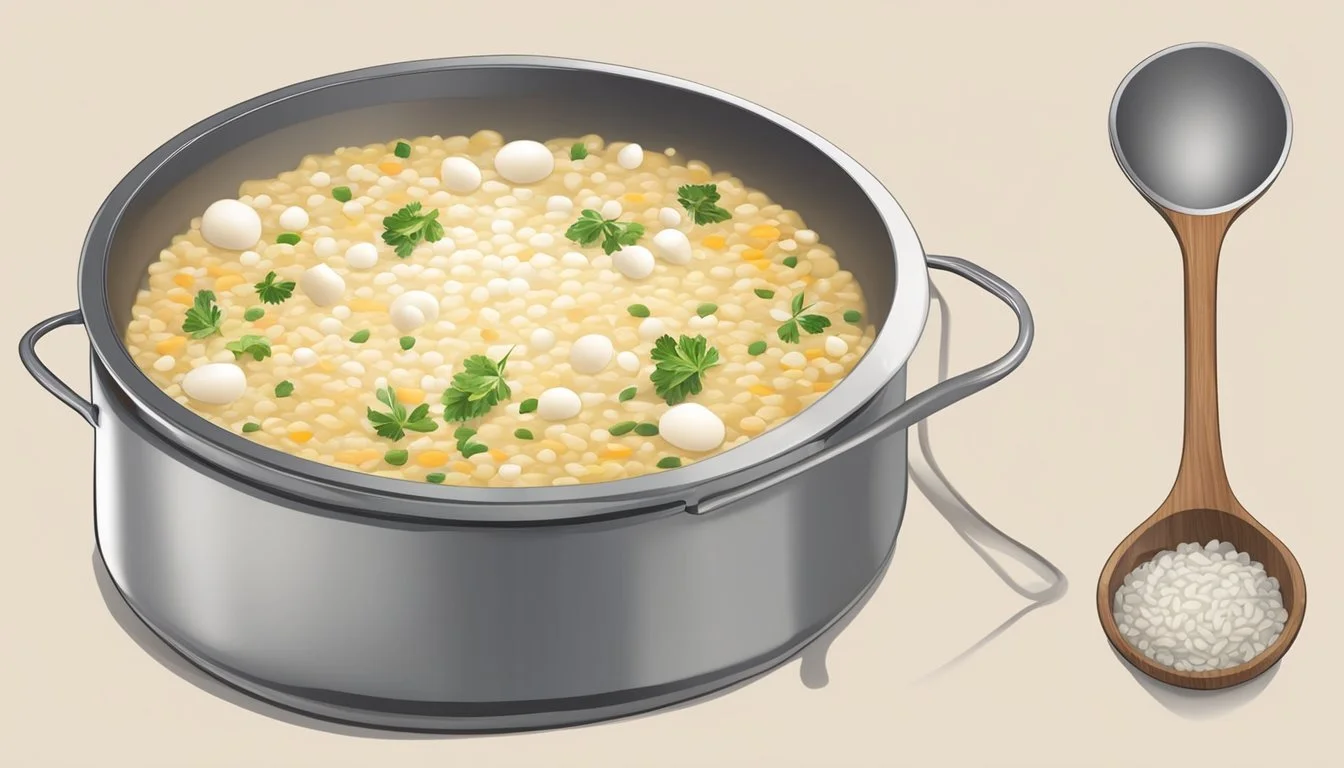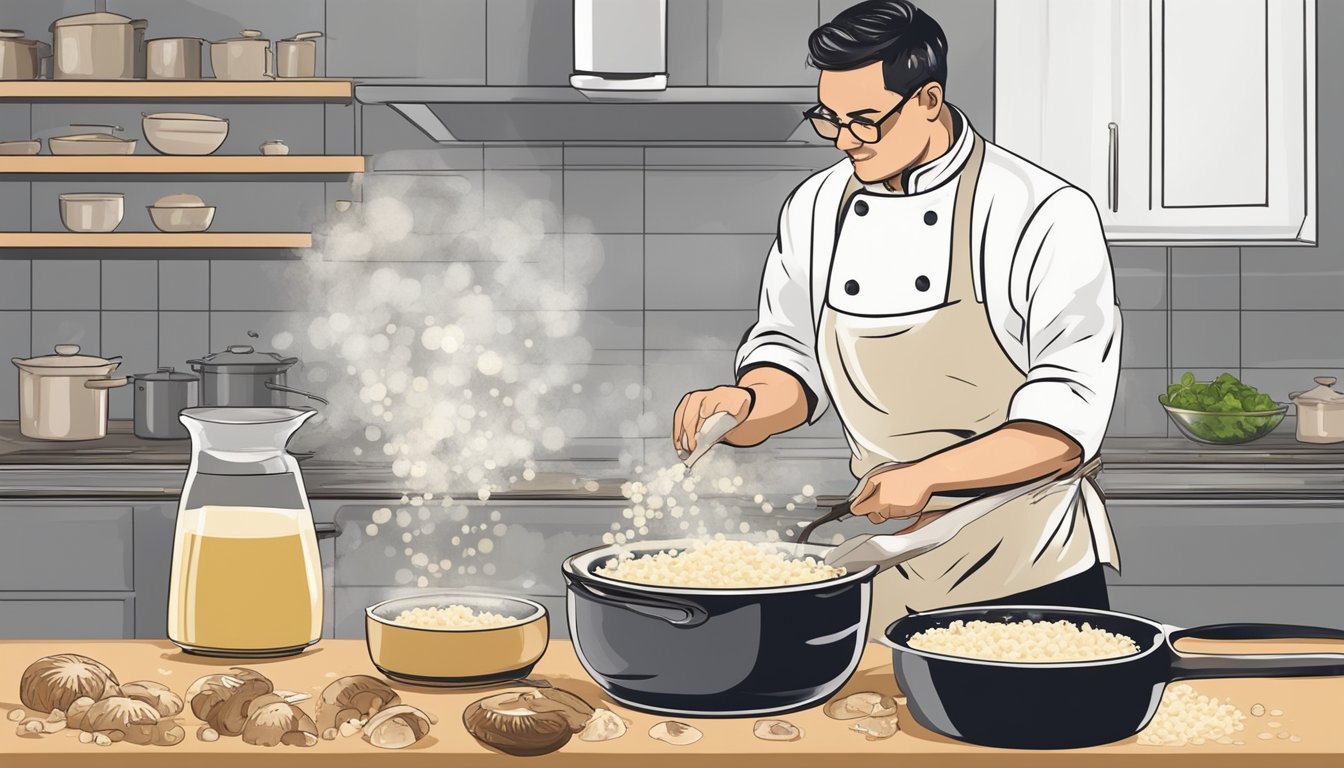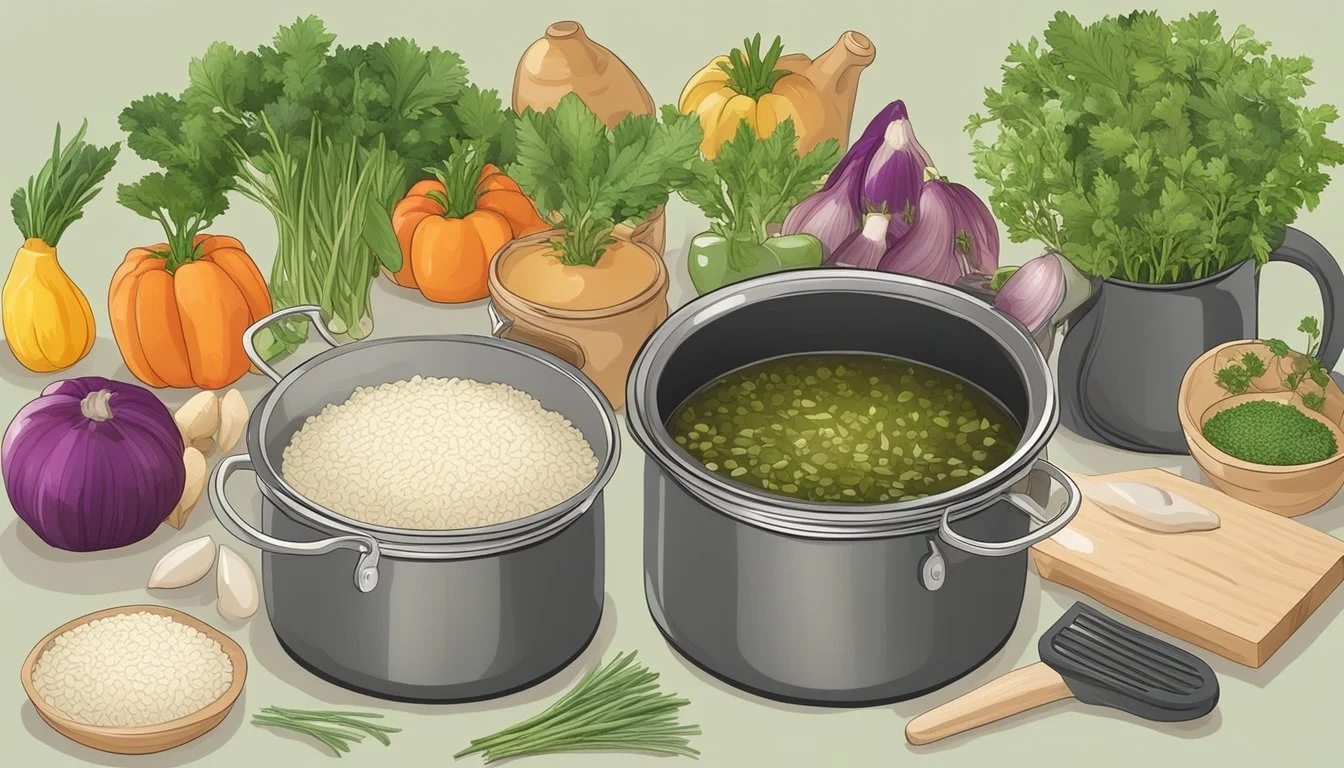Concocting a Creamy Risotto Without a Traditional Pan
Alternative Methods Explored
Crafting a creamy risotto often conjures images of a chef tirelessly stirring a pot, with the steam rising to fog up kitchen glasses. However, the traditional pan isn't the only vessel capable of producing this quintessential Italian dish known for its luxurious texture and depth of flavor. Innovative cooking methods and kitchen improvisation now enable the creation of a delectable risotto, even without the customary cookware.
In a world where culinary boundaries are constantly being pushed, the act of cooking risotto has evolved to embrace alternative methods. A casserole dish, for instance, can be employed to bake the rice in the oven, a technique that allows for a more hands-off approach while still delivering the creamy consistency risotto is celebrated for. This method also dispenses with the need for constant stirring, simplifying the process without compromising the quality.
The key to a successful risotto lies in understanding its core principles — the gradual absorption of liquid and the release of starch from the rice grains, resulting in a creamy emulsion. Whether using a sauté pan, Dutch oven, or even a casserole dish, these principles remain the same. By adapting to the tools at hand, chefs and home cooks alike can achieve the perfect harmony of rich creaminess and al dente bite that defines a well-made risotto.
Essential Ingredients for Risotto
Crafting the perfect risotto hinges on selecting premium ingredients that come together to create its distinctive creamy consistency and rich flavor. The following components are pivotal to its success.
Choosing the Right Rice
For risotto, short-grain varieties like Arborio, Carnaroli, or Vialone Nano are preferred for their high starch content, which contributes to the dish's creaminess. Arborio rice, widely available, is a common choice, but Carnaroli and Vialone Nano are prized for their ability to absorb liquids and flavors while maintaining a firm texture.
Stock Selection
A flavorful stock forms the liquid base, infusing the rice with depth as it cooks. Commonly used is chicken stock, but depending on the recipe, chefs might opt for vegetable, beef, or fish stock. A quality stock brings out the rice's subtle flavors, so homemade or high-quality store-bought stock is recommended.
Fats for Flavor
Fats are two-fold in risotto: butter and olive oil. They're used initially to sauté onions or garlic and to toast the rice, forming a flavorful base layer. In the finishing stage, a knob of butter can be stirred in to lend a glossy, velvety finish.
Cheese Choices
Parmesan (Parmigiano-Reggiano) is the classic cheese for risotto. It imparts a nutty and savory element and also contributes to a sumptuous texture. Beyond Parmesan, some variations may include cheeses like Pecorino or Gorgonzola, depending on the desired flavor profile.
Flavor Enhancers
To elevate the risotto beyond its basic components, a range of ingredients can be incorporated:
White wine: A splash added after toasting the rice deglazes the pan and lends acidity.
Salt and pepper: Essential for seasoning.
Add-ins like mushrooms, herbs, or cream can be folded in for additional taste and richness.
Risotto Cooking Techniques
Crafting the perfect risotto is an art that hinges on technique. This section breaks down the critical steps in the process to ensure a creamy, satisfying texture without the use of a traditional risotto pan.
The Importance of Sautéing
To initiate the process, one must sauté aromatic ingredients such as shallots or garlic in a heavy pot or Dutch oven. This crucial step lays the flavor foundation for the risotto and helps to impart a toasty depth to the Arborio rice as it lightly fries in the oil, ensuring the grains are well-coated and their edges become translucent.
Mastering the Stir
Stirring is essential to risotto as it facilitates the release of starch from the rice grains, which contributes significantly to the dish's iconic creamy texture. One must frequently stir the rice after each ladle of broth to prevent sticking and encourage even cooking, while being mindful to let the rice rest momentarily between stirs.
Simmering and Absorption
Risotto requires a patient and attentive approach to simmering and absorption. Adding the liquid (broth) gradually—about a ladle at a time—and waiting until it's mostly absorbed before adding more, allows the rice to cook evenly and draw out the desired creaminess. Maintain a gentle simmer throughout the process to avoid overcooking.
Determining Doneness
Identifying when the risotto is al dente, or 'to the tooth', is key. The rice should be tender with a slight bite and should not be mushy. Taste testing periodically is the best way to monitor the texture and ensure proper doneness—typically reached in 16-20 minutes of cooking time.
Finishing Touches
To culminate, one embellishes the risotto with finishing touches that elevate the dish from good to sublime. After the final addition of broth, and off the heat, fold in cold butter and grated Parmesan cheese, stirring gently until these ingredients are fully incorporated and the risotto reaches an ideal creamy consistency. Rest briefly before serving.
Each step in the risotto making process builds upon the last, creating layers of flavor and texture that make this dish a classic. With the right technique, even without a traditional pan, one can achieve the hallmark creaminess risotto is known for.
Alternative Cooking Methods and Pans
Mastering risotto doesn't hinge on the use of a traditional risotto pan. Chefs can achieve a creamy and delectable result using various alternative methods and pans, from skillets to ovens and pressure cookers.
Non-Traditional Pans
Skillet: A well-constructed cast iron skillet or a heavy bottomed stainless steel pan can be excellent options for making risotto. They retain heat well, which is crucial for maintaining a consistent simmering temperature. When cooking risotto in these non-traditional pans, chefs should ensure that their stirring technique effectively spreads the heat to prevent sticking and promote even cooking.
Oven-Baked Risotto
Oven: To make risotto in the oven, chefs do not need to stand by the stovetop to stir constantly. Using a casserole dish with a lid, or tightly covering it with foil, the rice can absorb liquid more evenly, as the oven's ambient heat circulates around the dish. Baking at a moderate temperature, typically around 350°F (175°C), enables the rice to cook uniformly, resulting in a creamy texture without constant attention.
Pressure Cooking Risotto
Pressure Cooker: A pressure cooker can substantially reduce risotto's usual cooking time while still delivering a creamy consistency. By sealing in steam and building pressure, the cooker forces liquid into the rice grains, ensuring they become tender in a fraction of the time. Most modern electric pressure cookers also have pre-set risotto functions, making this method nearly foolproof for busy cooks.
In each of these alternative methods, it's important for the cook to adjust liquid ratios and cooking times accordingly. The ultimate goal remains to produce a risotto that is creamy yet still has some al dente texture to the rice grains.
Specialty Risotto Variations
Risotto's adaptability shines through in specialty variations that cater to diverse palates, ranging from vegetarian delights to sumptuous seafood or meat-infused dishes.
Vegetarian and Vegan Options
For vegetarians, risotto offers a canvas for a rainbow of vegetables. Classic vegetarian options might include a Butternut Squash Risotto where the squash purée adds a natural creaminess without the need for dairy. Vegans can relish a Miso Pumpkin Risotto, with silky miso replacing traditional cheese for depth and umami. Key ingredients for these variations are:
Squash purée
Miso paste
Nutritional yeast (as a parmesan cheese substitute)
Seafood Infused Risotto
Seafood risotto can transport its eaters to the coasts of Italy with every bite. A Shrimp and Asparagus Risotto highlights the freshness of the sea with perfectly sautéed shrimp nestled among tender asparagus tips. For those seeking decadence, Scallop Risotto delivers a luxurious experience with rich, buttery scallops (What wine goes well with scallops?) complementing the creamy rice. Essential components for seafood risottos include:
Fresh seafood (shrimp, scallops)
Seasonal greens
Light, aromatic broth
Hearty Meat Risotto
Meat lovers need not feel left out when exploring risotto. A Sausage and Mushroom Risotto (What wine goes well with mushroom risotto?) combines savory sausage with earthy mushrooms, bringing a heartiness to the dish that satisfies even the most robust appetites. For a sophisticated touch, Steak Risotto incorporates tender pieces of steak, adding both texture and protein. Meat risotto variations often involve:
Quality cuts of meat (sausage, steak)
Rich stock bases
Complementary herbs and vegetables
Risotto as a Restaurant Staple
Risotto, a North Italian rice dish, has become a signature offering in many restaurants across the globe. It is renowned for its creamy texture and is often made with Arborio rice, a variety well-suited for risotto due to its high starch content.
Ingredients & Techniques: Restaurants often follow a traditional recipe that hinges on a methodical cooking process. The rice is toasted in fat—such as butter or oil—to which onions have usually been added for flavor. A splash of wine is commonly used to deglaze the pan, followed by the gradual addition of warm stock, which chefs stir constantly to release the rice's starch and produce that characteristic creaminess.
Why Restaurants Excel: Chefs at restaurants have mastered the nuances of this dish through repetition and understanding the precise timing needed. They have an edge in creating the perfect consistency and flavor of a cream risotto recipe, often elevating the dish with high-quality ingredients and a precise balance of seasoning.
Presentation: In a restaurant setting, risotto is typically served immediately after cooking to preserve its texture and temperature. Presentation is key, and it is often plated with a garnish of herbs or accompanied by other elements such as seafood or vegetables.
In summary, the expertise required to prepare a truly exemplary risotto and the effort invested in presentation solidify it as a beloved staple in restaurants.
Tips and Tricks for Perfect Risotto
Crafting the perfect risotto hinges upon meticulous attention to detail, from the consistency of the sauce to the choice of garnish. These tips and tricks guide home chefs in sidestepping common pitfalls and enhancing the overall dining experience.
Preventing Risotto from Becoming Gluey
Constant Stirring: A common misconception is that risotto requires non-stop stirring. Instead, one should stir occasionally, ensuring that the rice doesn’t stick to the pan while allowing it to cook evenly.
Temperature Control: Maintain a simmering temperature when adding liquid. Adding cold stock to the hot rice leads to a gluey texture, so it's preferable to keep it warm.
Correct Rice: Choosing the right type of rice, such as Arborio or Carnaroli, is vital. These grains have the correct amount of starch to achieve creaminess without becoming sticky.
Serving and Presenting
Immediate Serving: Risotto should be served right after it’s cooked to enjoy its creamy consistency. The longer it sits, the more the starches will firm up, leading to a thicker and less desirable texture.
Preheated Dishes: To prevent the risotto from cooling down too quickly, serve it on warm plates which helps in maintaining its creamy texture.
Visual Appeal: A garnish of freshly grated Parmesan or a sprig of thyme can enhance both the flavor and the appearance of the dish. A minimalistic approach is often best, as risotto should be the star of the plate.
Pairings and Accompaniments
Side Dishes: Risotto is a rich dish, pair it with something light such as a crisp green salad or a side of steamed vegetables. The contrast in texture and flavor will be appreciated.
Wine Pairings: A glass of a dry white wine that complements the richness of risotto can elevate the entire meal experience. Choose a wine that matches the risotto's flavor profile—seafood risotto pairs well with lighter wines, while mushroom risotto can be paired with something more robust.
Leftovers: Reheating and Storage
Managing leftovers effectively is vital for enjoying risotto beyond its initial serving. Proper storage techniques extend the dish’s lifespan, while careful reheating can restore its creamy texture.
Proper Storage Techniques
For storing risotto, one should always place it in an airtight container before refrigerating. This method helps in preserving both the flavor and texture of the risotto. The risotto should be cooled to room temperature before sealing to prevent condensation that could make it soggy. It's best to consume stored risotto within two days to ensure both safety and quality.
Reheating Without Losing Creaminess
When it comes to reheating leftovers, the goal is to maintain that signature creaminess. There are two preferred methods: using a microwave or a stovetop.
Microwave:
Add a tablespoon of broth or water per cup of risotto to introduce moisture.
Cover the bowl with a lid or a damp paper towel to keep it moist.
Heat in 30-second intervals, stirring between each to distribute heat evenly.
Stovetop:
Place risotto in a pan and add 2-3 tablespoons of broth per cup.
Simmer on medium heat, stirring frequently until the risotto warms thoroughly and regains its creamy consistency.
Each method ensures the risotto is reheated gently, encouraging the creamy texture to reemerge without drying out the rice.
Nutritional Information and Diet Considerations
When considering the nutritional profile of risotto, it's essential to recognize that it is a calorie-dense dish. The calorie content can vary, but on average, risotto provides about 368 calories per 100-gram serving. This is mainly due to the rice and added ingredients such as cheese and cream.
Fat content, particularly in versions with added cheese and butter, may contribute to the overall richness. Risotto typically has around 6.1 grams of fat per 100 grams, but this can be higher with additional dairy.
In the context of sodium, risotto can be quite high, with about 1193 milligrams per 100 grams. If one is monitoring their salt intake, it is advisable to be mindful of this.
Carbohydrate-wise, risotto is rich, providing 66.7 grams per 100 grams; within this, the fiber content can be negligible unless prepared with high-fiber ingredients. Risottos can contain simple sugars, around 7 grams per 100 grams.
However, risotto lacks in fiber and essential vitamins and minerals unless enriched with vegetables, fruits, or legumes. In terms of protein, risotto offers a moderate amount, with about 12.3 grams per 100 grams, largely influenced by whether it's prepared with meat, seafood, or cheese.
People following specific dietary needs can adjust the preparation of risotto:
For a gluten-free diet, ensure that all stock and added components are devoid of gluten.
To reduce fat, use less cheese and substitute cream with lower-fat milk or plant-based alternatives.
For a healthier version, incorporate a variety of vegetables to increase nutrient density.








